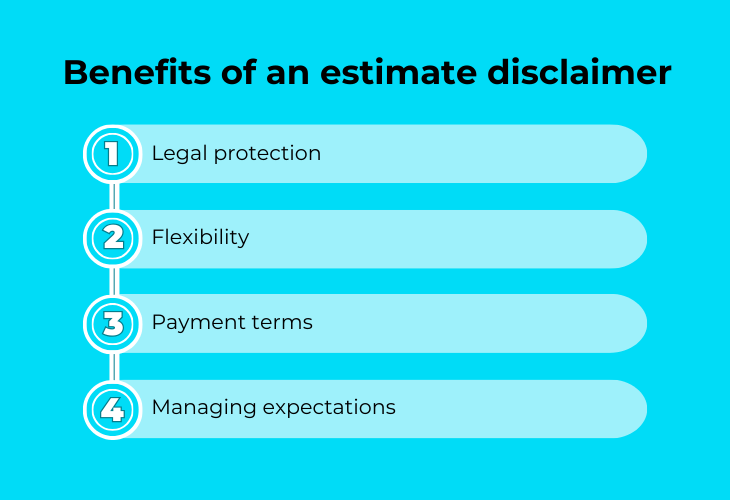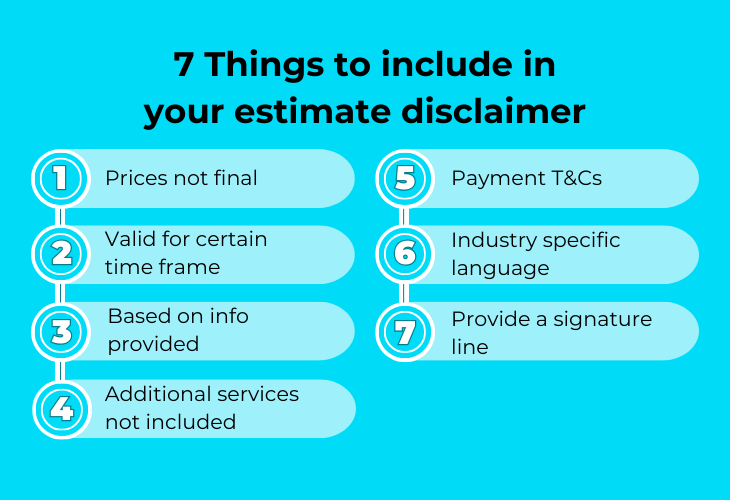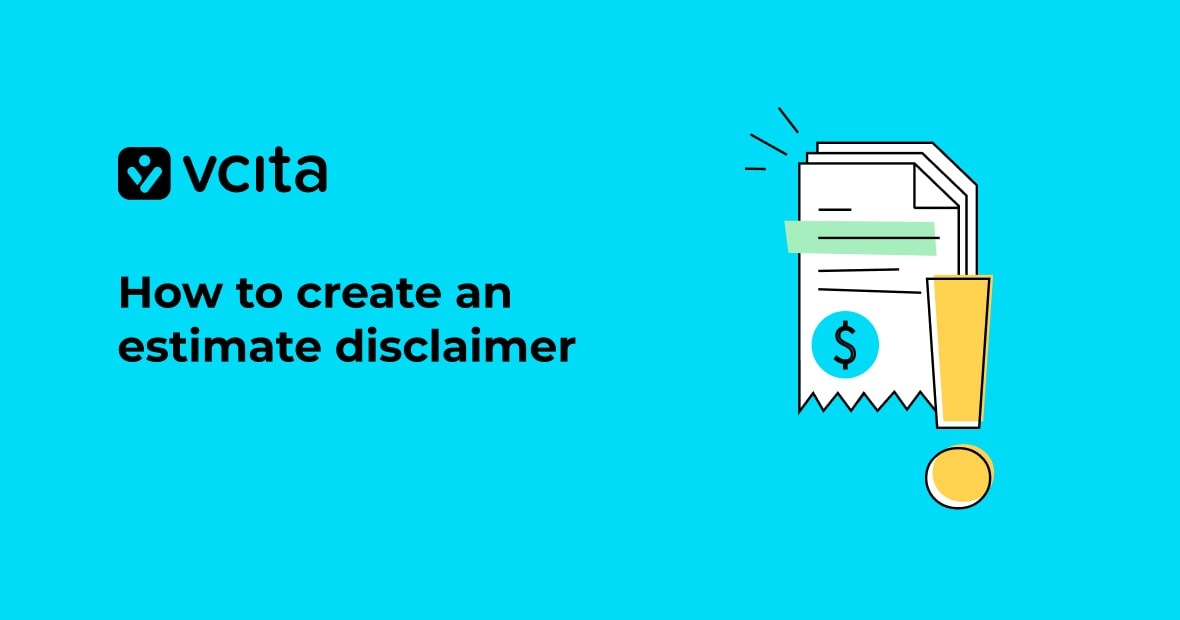As a small business owner, you know how important it is to set clear terms and conditions upfront before taking on a new project. An estimate disclaimer makes detailed estimate terms, conditions, and payment info part of the contract between you and a client.
Writing an estimate disclaimer helps protect your small business from disappointed clients. Read on for estimate disclaimer samples, terms and conditions templates, and tips for creating an estimate disclaimer that reduces ambiguity and protects your small business.
What is an estimate disclaimer and why your small business needs one
An estimate disclaimer is a statement you include with your estimate that clarifies the estimate is not a quote or binding agreement. It specifies that the actual price may vary from the estimate based on changes to the project requirements or other factors outside of your control once work begins.
As a small business owner, you likely provide estimates for your services to give clients an idea of the expected costs. However, estimates are just approximations. To protect yourself in case the final price differs from your initial estimate, you need an estimate disclaimer.
An estimate disclaimer allows you to adjust your pricing if the scope of work changes, helps prevent misunderstandings about the estimate you sent, and gives you legal protection in case there are any disagreements down the road. It can also help set expectations about payments and the work you’ll provide.
The benefits of an estimate disclaimer

As a small business owner, including an estimate disclaimer protects you and provides clarity for your customers. Here are the main benefits:
Legal protection
An estimate disclaimer makes it clear that the initial estimate is not legally binding and is subject to change based on new circumstances once work begins. This protects you if the final bill ends up being higher than expected, due to changes in project scope or requirements.
Flexibility
An estimate disclaimer allows for flexibility if anything about the job changes. For example, if the client requests any additional services or if you discover any unexpected challenges once the work starts, an estimate disclaimer ensures you have room to adjust the final price accordingly within a reasonable amount.
Payment terms
An estimate disclaimer also outlines your payment terms and conditions, including any upfront deposit, when payments are due, and acceptable payment methods like cash, check, credit card or electronic payment. This ensures there are no surprises for either party regarding when and how you expect to be paid.
Managing expectations
A detailed estimate disclaimer helps set proper expectations upfront regarding what your company will perform, the time frame for completion and any limits or exclusions. This minimizes the chance of confusion or dissatisfaction with the final result and bill.
Key elements to include in your estimate disclaimer
Your estimate disclaimer should specify the following issues.
Payment terms
Clearly state when and how payments should be made, as well as any fees for late payments. For example, “Payment is due within 30 days of invoice date. A 5% late fee will be charged for payments made after 30 days.” You may also want to specify if you accept electronic payment, checks, credit cards, etc. and include any relevant details like credit card expiration date.
Subject to change
Make it very clear that the estimate is subject to change based on the project requirements. For example, “This estimate is based on the information provided and is subject to change. Final price may vary depending on additional services required to complete the work.” This protects you in case the scope of work alters or unforeseen issues come up.
Project scope
Explicitly define what services your company will perform and the time frame to complete the work. For example, “This estimate includes materials and labor to paint the exterior of the property located at 123 Main St, completion within 3-4 weeks of project start date, weather permitting.” Be as specific as possible about what is included to avoid confusion.
Terms and conditions
Include your standard terms and conditions, so as to specify responsibilities and ensure you have a legally sound agreement if the estimate turns into a contract. Many small businesses use general or industry-specific terms and conditions samples as a template. Be sure to modify the wording to reflect your company’s specific policies.
How to write an estimate disclaimer: 7 vital things you need to include

It’s up to you how you write your estimate disclaimer and what wording you use, but there are 6 common issues which you have to address. Here are the 7 pieces of information that you need in any effective estimate disclaimer.
- This estimate is not a final price. This makes it clear to the customer that the price could change.
- This estimate is only valid for a certain time frame, such as 30 days from the date on this document. This allows you to revise the scope and prices and encourages the customer to book the work.
- This estimate is based on the information provided by the customer, so that if project requirements change, you can adjust the final price.
- Additional services not included in the original estimate may incur extra fees. This protects you in case you have to do more work than originally estimated.
- Payment terms and conditions, specifying when payment is due and acceptable methods of payment like cash, check, credit card or electronic payment.
- Industry specific language and include details relevant to your particular business or service.
- Provide a signature line for the customer to sign, accepting the terms of the estimate. This makes the disclaimer legally binding.
Most importantly, Be transparent about what your company will and will not perform for the estimated price, so that you clearly set expectations upfront to avoid confusion or disputes later on. It’s a good idea to have a lawyer review your estimate disclaimer, to ensure it complies with your local laws and protects your business.
Estimate disclaimer samples and template
Here are a few sample estate disclaimers to help you get started writing your own.
Basic estimate disclaimer sample
“The estimate provided is based on the information given at the time of the estimate, and is subject to change. Additional services requested will be billed separately. “
Time-based estimate disclaimer sample
“The price quoted is valid for 30 days from the date of this estimate. If the work has not commenced within 30 days, we reserve the right to revise the estimate.”
Payment terms estimate disclaimer sample
Unless agreed upon prior to commencement of work, delivery, or services, payment will be due in full upon completion. Where a quotation has been given, the full amount due, less any payments made, is payable. Where a quotation has not been provided, The Company’s agent will advise the customer of the amount due and will provide a detailed invoice within 72 hours.
All prices include sales tax at the appropriate rate.
Acceptable methods of payment are:
- Electronic Payment (insert method)
- Check
- Cash
Payment is due within 14 days of receipt of this invoice. Late payments will be charged a fee of 5%.
Customizing your estimate disclaimer for your industry
Including an estimate disclaimer tailored to your industry can help avoid confusion and protect you legally. For example, if you run a construction company, your estimate disclaimer may specify that your company will perform the services as described in the detailed estimate terms and conditions sample, based on the current project requirements and site conditions. You can also add that your business doesn’t bear liability for defects in existing installations.
If you own a web design firm, your estimate disclaimer may state how many drafts you’ll provide, how many rounds of edits are included in your quote, and whether you’ll be available by phone or text message. It may also mention that additional fees will apply if more than three rounds of revisions are needed.
Be sure to also include standard terms and conditions samples regarding payment methods (e.g. credit card, electronic payment), the expiration date of the estimate, and your refund/cancelation policies.
A customized estimate disclaimer provides clarity for your clients and protects your business. Using industry specific estimate disclaimer samples as a starting point, you can craft one to address liability issues particular to your field.
An estimate disclaimer should be part of your business routine
Including an estimate disclaimer is an easy way to protect your small business while also providing clarity for your customers regarding what they can expect. Adding one can help set proper expectations with your clients and protect your business. When done right, an estimate disclaimer benefits both parties and leads to a smooth working relationship. With the right detailed estimate terms and conditions in place, you can feel confident that you’ll have a successful project.




























